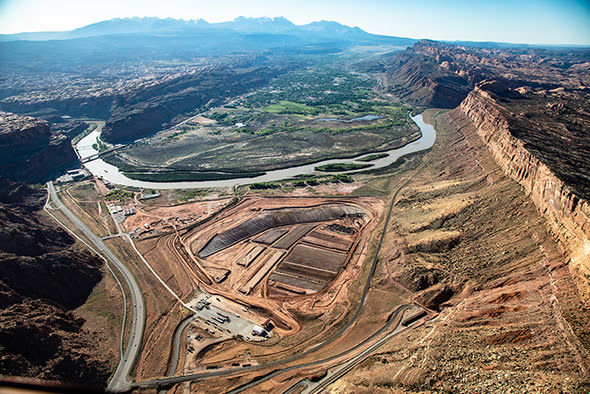By his own count, when Lee Shenton steps down from the position of Moab Uranium Mill Tailings Remedial Action (UMTRA) Project community liaison on July 31, he will have served for 3,207 days.
“But who’s counting?” Shenton said with a chuckle.
It was apt that Shenton knew the number, since being exact about facts and figures is an important part of his job. Now, those job duties are being assigned to Shenton’s replacement, Russell von Koch.
Von Koch has specialized knowledge and experience with the Moab UMTRA Project. He served as the Site Futures Committee Chair for the project twice, and most recently helped to facilitate a public meeting on the future use of the land at the project site.
Von Koch began his official work as community liaison on Monday, July 23.
As liaison, he will now work to facilitate communication between the Grand County community and the Department of Energy (DOE) about the remediation work at the Moab UMTRA Project site, a former uranium processing mill on the banks of the Colorado River just north of Moab. The decades-long project to relocate all of the radioactive tailings to an environmentally secure site about 40 miles north of Moab is about 58 percent complete and scheduled to be finished by 2034, based on current funding levels.
Like Shenton, von Koch’s duties will include preparing informational reports for the steering committee. Grand County’s Moab Tailings Project Steering Committee (MTPSC) was formed in 2012.
Von Koch will continue to develop and revise recommendations for the steering committee on the future use and planning of the Moab UMTRA Project site.
In searching for Shenton’s successor, Grand County Community and Economic Development Director Zacharia Levine said the county formed a hiring committee. The position was publicly advertised. Candidates needed to have experience in community engagement, meeting facilitation and multi-agency coordination. Levine said von Koch was offered the position once the hiring committee reviewed the applications and conducted interviews.
Von Koch first became acquainted with the work of the liaison in 2013 while helping to develop the Initial Community Vision for future use of the Moab UMTRA Project site. Once the remediation process is complete, the land may be turned over to the local community for development.
“The Moab UMTRA project is of great importance to Moab and Grand County,” von Koch said.
Levine agreed on the project’s importance.
“The range of potential uses that may be possible on the site following the clean-up creates an enormous opportunity for the community, both in terms of quality of life amenities and economic development,” Levine said.
From 1983 to 2012, von Koch helped to manage BLM recreation areas, which gave him experience in working with multiple agencies and engaging with the community.
“While I still have much to learn about the Moab UMTRA Project, I am hopeful that my background will help me work with local stakeholders, citizens and the DOE,” von Koch said.
Shenton expressed confidence that von Koch’s background will be beneficial in the community liaison position.
“Russ von Koch is a terrific selection for my replacement,” Shenton said.
The Grand County Council approved Shenton to work as an independent consultant for 90 days to assist and train von Koch on the technical aspects of the position.
“Planning for potential future use of the UMTRA project (site) is far from complete,” von Koch said. “Past resolutions approved by Grand County and the City of Moab require updating the Community Vision every five years.”
The Site Futures Committee conducted a planning and public outreach effort in the spring, and its report will be presented at the MTPSC meeting on July 31.
“There are opportunities for citizen engagement at each of these steps,” von Koch said.
When asked if he had any lessons he had learned on the job that he wished to pass on, Shenton said, “You need to develop trust and credibility yourself with the project team and the community. That means you don’t exaggerate or understate anything. You share facts and not speculation, unless you are asked for speculation, in which case you identify it as such.”
Shenton recalled that one of the hurdles he had to overcome as community liaison was the public’s misunderstanding of what the project was going to do, how fast it was going to do it and the potential risks to the public.
For the first several years, Shenton said, he would look at the data and the technical reports and compare the risk levels to general things the public could relate to, like getting an X-ray.
“People have a harder time relating to radiation in particular,” Shenton said. “They think of Three Mile Island and Chernobyl.”
Shenton said that even with clear communication on scientific data — indicating the Moab UMTRA Project remediation project is not a safety risk for the public — some people remain skeptical.
“I think there will always be a part of our community that distrusts government for one reason or another,” Shenton said. “But, every citizen deserves a respectful response to their concerns.”
With his time as community liaison coming to an end, Shenton said he looks forward to continuing his work with the Utah Friends of Paleontology and expressed a positive feeling for the job he is leaving.
“It’s been really gratifying work,” Shenton said. “It was right in my strike zone for what I could do to help the community.”
“I want to acknowledge Lee Shenton,” Levine said, “and the incredible job he did for the community serving in this position from its inception in 2009 until now … Lee will be greatly missed, and I will always appreciate his contributions to this office and the community at large.”
Torch passed from Shenton to von Koch
“Von Koch is a terrific selection.”




